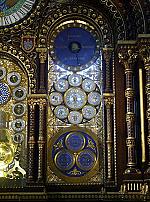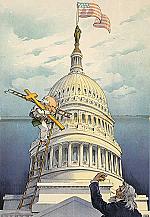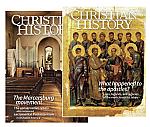Recommended resources: Fasts and Feasts

Books
If you want to learn more about the theology behind the Christian year, start with Thomas Talley, The Origins of the Liturgical Year (1991); Laurence Hull Stookey, Calendar: Christ’s Time for the Church (1996); Bobby Gross, Living the Christian Year (2009); James F. White, Introduction to Christian Worship (4th ed. 2023); and Steven Brooks, Seasons of Worship (2024).
Books that introduce liturgical theology and liturgical history in general often have resources on the Christian year; a classic here is The Study of Liturgy, ed. Cheslyn Jones et al. (rev. ed. 1992); one from a more evangelical perspective is Ever Ancient, Ever New by Winfield Bevins (2019); and the most comprehensive is Geoffrey Wainwright and Karen Westerfield Tucker, eds., The Oxford History of Christian Worship (2005).
Some practical resources for incorporating the church year into your own congregation’s or family’s life include Peter Bower, Handbook for the Common Lectionary (1987); Evelyn Birge Vitz, A Continual Feast (1991); Hoyt Hickman et al., The New Handbook of the Christian Year (2nd ed. 1992); Robert Webber, ed., The Services of the Christian Year (1994); Peter Mazar, To Crown the Year (2007); Malcom Guite, Sounding the Seasons: Poetry for the Christian Year (2012); Christine E. Curley, The Church Year at Home (2021); and Kendall Vanderslice, Bake and Pray (2024). One guide for a specifically Roman Catholic audience is Greg Dues, Catholic Customs and Traditions (rev. ed. 2009), and one Orthodox guide is John Kosmas Skinas, Heaven Meets Earth: Celebrating Pascha and the Twelve Feasts (2015).
Choose from a number of devotional books with readings to enrich your experience of the seasons; a small selection includes the Sourcebooks for Advent, Christmas, Lent, Triduum, and Easter from Liturgy Training Publications (1988–1996); Imaging the Word: An Arts and Lectionary Resource from United Church Press (1994–1996); Watch for the Light: Readings for Advent and Christmas (2001) and Bread and Wine: Readings for Lent and Easter (2003) from Plough; and CHI’s very own The Grand Miracle for Advent (2019) and Walk Through the Wilderness for Lent (2022). Your own denomination may also have online or print resources published on a recurring basis. To start thinking about the whole of the Christian life as a rhythm of fasting and feasting, the Every Moment Holy books from Rabbit Room Press are a great introduction (2017–present).
Classic introductions to Orthodox worship and theology include Kallistos Ware, The Orthodox Church (3rd ed. 2015) and The Orthodox Way (new ed. 2019); and Alexander Schmemann, For the Life of the World (1997). Other resources include Thomas Hopko, The Orthodox Faith (1981/2016); Hilarion Alfeyev, The Worship and Liturgical Life of the Orthodox Church (2017); and Nicholas Denysenko, This Is the Day That the Lord Has Made: The Liturgical Year in Orthodoxy (2023).
Countless books offer saint stories and resources for celebrating saints at home or in church. Here are a few selected ones—Catholic, Protestant, and Orthodox: James Bentley, A Calendar of Saints (1986); Joseph Tylenda, Saints and Feasts of the Liturgical Year (2003); Alfredo Tradigo, Icons and Saints of the Eastern Orthodox Church (2004); Sisters of Notre Dame Chardon Ohio, Saints and Feast Days (2006); Philip H. Pfatteicher, The New Book of Festivals and Commemorations (2008); Heather Josselyn-Cranson, ed., For All the Saints (2013); William Weedon, Celebrating the Saints (2016); Enzo Lodi, Saints of the Roman Calendar (2017); The Episcopal Church, Lesser Feasts and Fasts (2018 and previous editions); and Sarah Wright and Alexandra Schmalzbach, 101 Orthodox Saints (2021).
Christian History issues
These past issues of Christian History relate to this issue. Read online or purchase hard copies when available:
37: Worship in the Early Church
49: Everyday Faith in the Middle Ages
83: Mary in the Imagination of the Church
103: Christmas
125: Food and Faith
129: Recovery from Modern Amnesia
146: Christ and Culture in Russia
147: Everyday Life in the Early Church
156: What Happened to the Apostles?
Guide: Worship from Constantine to the Reformation
Videos from Vision Video
Videos on this issue’s theme include the six-part series A History of Christian Worship as well as Augustine: A Voice for All Generations; Apostle Paul and the Earliest Churches; Blessing Europe: Legacy of the Celtic Saints; Charting Christmas; The History of Orthodox Christianity; In the Footsteps of Saint Peter; The Passion of Christ According to St. Francis; Patrick; Paul the Apostle; Perpetua: Early Church Martyr; Pioneers of the Spirit; Polycarp; Saint Nicholas; Saint Patrick; To the Ends of the Earth; and many other lives of famous Christians including our Torchlighters series for children. Some of these titles are available for purchase as DVDs; you can access all of them on our streaming platform, Redeem TV.
Websites
You’ll find some primary sources devoted to this topic at the Christian Classics Ethereal Library (Egeria’s diary is there, for example) and at the Fordham Sourcebooks (particularly the Medieval one).
If your church celebrates the liturgical year, it probably has a website or portion of a website devoted to explaining the church calendar. Here are some denominational resources to get you started, focused on the United States and Britain:
• Anglican Church in North America (also provides links to worldwide Anglican resources)
• Catholic Church in England and Wales
• Episcopal Church (see also The Lectionary Page)
• Evangelical Lutheran Church in America
• Greek Orthodox Archdiocese of America (see also its page about Feasts of the Church)
• Lutheran Church—Missouri Synod
• Presbyterian Church (U.S.A.)
• US Conference of Catholic Bishops
The most famous site devoted to worship resources organized around the Revised Common Lectionary is probably the Vanderbilt Library site; the library also maintains a partner site, Art in the Christian Tradition. The Text This Week incorporates multiple lectionaries and is specifically geared for preachers, and The Hymn Site provides hymn selections. A few other good resources include Art and Theology, the Consultation on Common Texts (which developed the RCL), and Satucket Lectionary.
Many sites provide resources about saints. The Cult of Saints attempts to be a comprehensive history of saints from the earliest days of the church to 700 AD. The Vatican publishes a Saint of the Day page according to the Roman Catholic calendar (several other Catholic websites do too including Catholic.org and Franciscan Media), and the Orthodox Church in America does the same from the Orthodox perspective, as does Ancient Faith Ministries. For Protestant lists (with an Anglican flavor), you can start with “James Kiefer’s BIOs” and Satucket. Our own Today in Christian History often refers to saints, and our blog covers topics concerning the church calendar.
Finally, My Jewish Learning is a good site to understand Jewish fasts and feasts on their own terms from a Jewish perspective. CH
By The editors
[Christian History originally published this article in Christian History Issue #156+ in 2025]
Next articles
Questions for reflection: Fasts and feasts of the church
Reflect on themes of sacred time.
The editorsDid you know? Vatican II
A helpful introduction to terms and ideas as you begin the Vatican II story
the editorsLetters to the editor, Vatican II issue
Readers respond to Christian History
our readers and editorsSupport us
Christian History Institute (CHI) is a non-profit Pennsylvania corporation founded in 1982. Your donations support the continuation of this ministry
Donate







